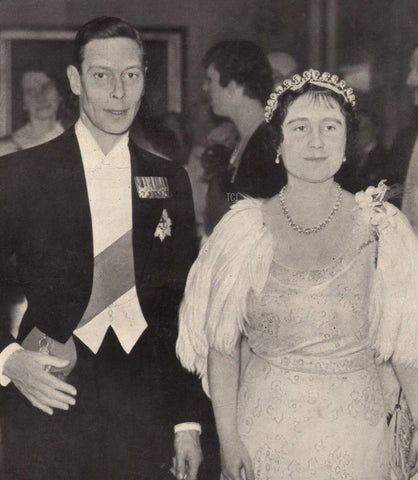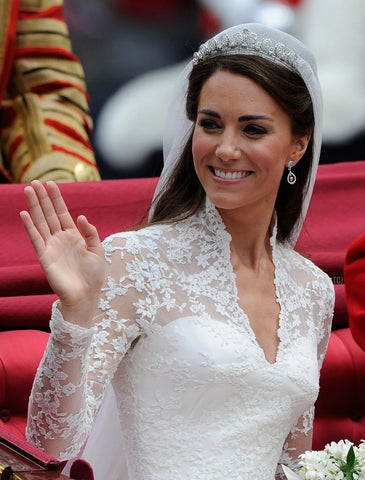The Cartier Halo Tiara: A Gleaming Legacy of Royal Elegance
The Cartier Halo Tiara, with its unique allure and historical significance, has transcended through eras, symbolizing royal elegance and embodying the magnificent craftsmanship of Cartier. Created in 1936 and designated by a lineage of royal women, this tiara holds a special place in royal history and jewelry craftsmanship.
A Gift of Love: The Initial Ownership

Duke and Duchess of York on November 4, 1936, at a charity ball at Claridge’s in London to benefit the South London Hospital for Women. It was their first gala outing since the official ending of the lengthy court mourning period for the late King George V // John Frost Newspapers/Alamy
In the realm of royal treasures, where each piece is meticulously crafted and holds tales of timeless elegance, The Duke of York's commissioning of the Cartier Halo Tiara for his beloved wife, the Duchess of York, Elizabeth, stands out as a remarkable story of love, devotion, and royal tradition.
It was November 1936, a period during which the world was teetering on the brink of significant geopolitical shifts; however, within the walls of the British monarchy, a tender narrative unfolded. Albert, who would unexpectedly ascend to the throne as George VI in December of that year following his brother's abdication, sought to provide a symbol of his admiration and love to his supportive and steadfast wife. Consequently, he commissioned Cartier, a name synonymous with luxury and exquisite craftsmanship, to create a piece that would reflect not only the aesthetic opulence befitting a royal but also embody the personal and intimate affections he held for Duchess Elizabeth.
This exquisite piece was designed with meticulous craftsmanship, capturing the essence of regality and delicacy in its scrolls and floral motifs. Despite its magnificent allure, the Duchess of York was known to wear the Halo Tiara on very few occasions. By the time she became Queen Elizabeth, she possessed a collection of much larger and more stately tiaras, which more prominently featured in her public appearances. However, the Halo Tiara held a unique position within the royal collection, symbolizing the heartfelt and genuine connections that even monarchs, often veiled by their titles and duties, hold dear.
Passing Down Through Generations: The Story of Gifting

Princess Margaret wearing the Cartier Halo Tiara in April 1958 for dinner to celebrate the 40th anniversary of the Royal Air Force at Fighter Command HQ at Stanmore // PA Images/Alamy
When the Cartier Halo Tiara was gifted to Princess Elizabeth by her mother, Queen Elizabeth, in the spring of 1944 for her 18th birthday, it signified more than just the transfer of a precious item. It represented a symbolic gesture, a maternal blessing, and the passing down of a familial tradition through the tiara. The Queen Mother, known for her robust and unyielding spirit, especially during the war-torn times, bestowed upon her daughter not merely a magnificent piece of jewelry but also a mantle of heritage and royal dignity.
The Cartier Halo Tiara, became a symbol of Princess Elizabeth’s transition into adulthood and her impending responsibilities as the future monarch. Though the tiara was not among those frequently chosen by the Princess for her numerous public appearances, it remained a piece rich in personal value and historical significance.
In the same spirit of familial bonds and cherished traditions, Princess Margaret, Princess Elizabeth’s younger sister, was often seen adorning the splendid Halo Tiara, demonstrating not just the shared treasures of the royal family but also a reflection of their closely-knit relationship. Princess Margaret, known for her vivacious spirit and keen sense of fashion, brought her own charisma to the tiara, making it emblematic of both royal grandeur and the vibrant, buoyant energy she was renowned for.
Margaret wore the tiara to various events and occasions, each time illuminating her surroundings with the tiara’s radiant diamonds and her own inimitable style. Margaret made her first appearance in the tiara during the inauguration celebrations for Queen Juliana of the Netherlands in September 1948. Margaret also wore the jewel at Elizabeth's June 1953 coronation. The Cartier Halo Tiara, therefore, became not merely an artifact of royal opulence but a versatile emblem that transcended generations and personal styles within the Windsor family.
Thus, from the Queen Mother’s gentle elegance to Princess Elizabeth’s dignified grace, and further to Princess Margaret’s lively charm, the Cartier Halo Tiara witnessed varying personas and eras, embedding within its sparkling scrolls stories of love, transitions, and the undulating journey of a royal lineage.
The Design and Craftsmanship: Cartier’s Mastery

Diamond Details: The tiara boasts 100 carats of diamonds, comprising 739 brilliant-cut and 149 baguette-cut stones, elegantly arranged to form a halo of luminous brilliance. The diamonds' cut and arrangement are quintessential to Cartier’s style, optimizing sparkle and sophistication.
Metal Base: Crafted primarily in platinum, the tiara exemplifies luxurious durability, providing a sturdy yet lightweight base for the plethora of diamonds.
Creator and Creation Time: Cartier, recognized globally for its exquisite jewelry, created the tiara in 1936, reinforcing its prowess in crafting timeless pieces for high-profile clientele.
Gemological and Geological Intricacies
The diamonds, with their particular cuts and splendid clarity, are significant contributors to the tiara's allure. While the precise geological origin of the diamonds is not widely documented, the gemological expertise of Cartier in selecting and setting such splendid stones is unquestionable.
The Most Memorable Appearances: Kate Middleton’s Wedding

Kate Middleton wears the Cartier Halo Tiara on her wedding day in 2011 // Paul Hackett – WPA Pool/Getty Images
April 29, 2011, witnessed a modern fairy tale unfold as Catherine Middleton stepped into Westminster Abbey, poised to embrace her future as a member of the British Royal Family. On this monumental day, amidst the grandeur and tradition that enveloped the royal wedding, perched atop Kate's beautifully styled hair was the Cartier Halo Tiara, a piece with a lineage and history as rich as the monarchy itself.
The choice of the Cartier Halo Tiara was one imbued with significance and subtle messages, intertwining respect for royal tradition with Kate's own personal style. Despite having access to a plethora of tiaras, with larger, arguably more opulent designs, Kate's selection of the relatively delicate Halo Tiara spoke volumes of her elegant, understated style and her respect for the piece's storied history within the royal family.
This decision also hinted at a modern reimagining of royal norms. The tiara, though rich in history, was not among the most frequently worn pieces by the royals in preceding generations. Kate's choice to don it on such a significant occasion not only highlighted the tiara's elegance but also brought it into contemporary light, ensuring its story would be etched into the annals of modern royal history.
One of the profound aspects of Kate’s choice lies in its subtlety and delicate grace, mirroring her own approach towards royal duties and public appearances. It's in the merging of her personal style with a visible respect for the customs and legacy of the monarchy, where Kate has successfully navigated her journey as a royal. Donning the Halo Tiara, a piece that witnessed the life and times of previous monarchs and now elegantly graced her own story, Kate gracefully bridged generations, linking the past, present, and future through a single, symbolic choice.
Through the glittering scrolls of the Cartier Halo Tiara, Kate Middleton, who became the Duchess of Cambridge at that time, echoed stories of bygone eras while simultaneously crafting her own. As she walked down the aisle, beneath the arches of tradition and expectation, she did so with a nuanced blend of personal authenticity and respect for the storied lineage she was joining. Thus, the tiara became not only a sparkling accessory of the day but a symbolic torch, passed through generations and now lighting the way for a modern evolution of royalty.
The tiara not only stands as a beacon of luxurious craftsmanship but also as a tangible witness to the lives, loves, and transitions of the women who have worn it. Each reflection in its carefully cut diamonds tells stories of the past, present, and future, intertwining tales of duty, sisterhood, and the evolving narratives of the British Royal Family.
The Value Beyond Price Tags
While its exact value is undisclosed, the Cartier Halo Tiara’s worth transcends its impressive gemological specifications. Its historical significance, royal lineage, and the craftsmanship of Cartier render it priceless. Insurances value such pieces, taking into account not just the materials and craftsmanship, but also its historical and symbolic value. The tiara is estimated to be valued at over $2 million.
Conclusion:
The Cartier Halo Tiara stands as a testament to the timeless elegance of royal jewelry, weaving together stories of love, tradition, and meticulous craftsmanship. From the Queen Mother to Queen Elizabeth II, and illuminating the bridal path of Kate Middleton, this tiara has become an eternal symbol of grace and regality within the British Royal Family. Its intricate design, profound history, and the mastery of Cartier converge, crafting a story that will continue to gleam through the annals of time, as it is passed down to future generations of the monarchy.

Leave a comment